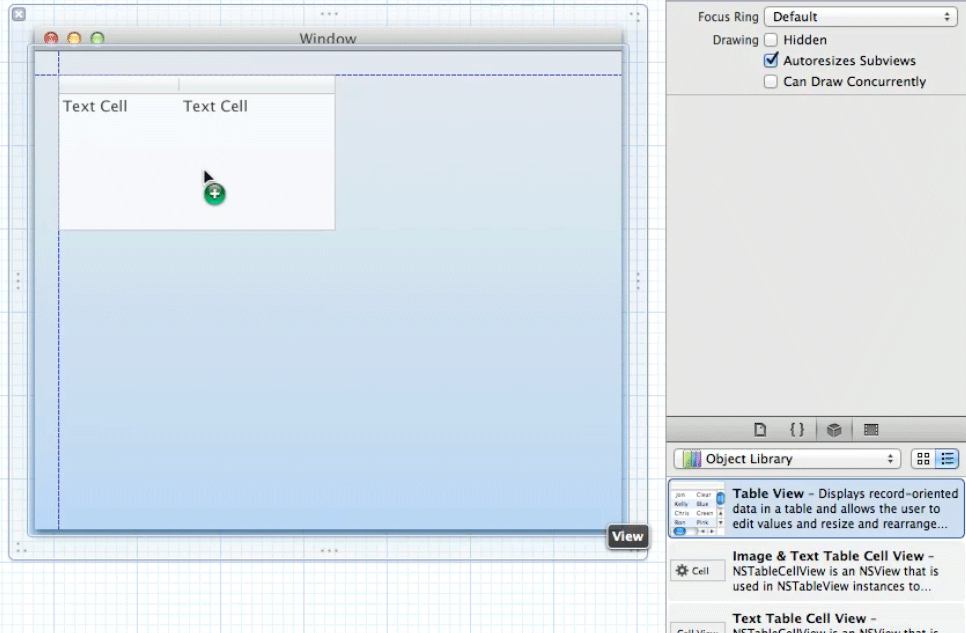Drag an instance of NSTableView from the object library onto the window object. Resize the table to fill most of the window but leave room on the bottom for a button.
Notice that the object’s edges snap to guides when they approach the edges of the window or other objects. These guides align view objects in accordance with Apple’s Human Interface Guidelines, or HIG. These are the rules that any developer should follow when designing user interfaces for the Mac. There are also HIGs for the iPhone and iPad. You can find all of the HIGs in the developer documentation.
Now you’re going to set some of the table view’s attributes in the attributes inspector. Normally, you click on an object on the layout grid, and the inspector changes context to show you the attributes of that object. Getting to the attributes of an instance of NSTableView is trickier. The table view object that you dragged onto the window is actually a collection of nested objects: an NSScrollView, an NSTableView, and one or more NSTableColumn instances. To get to a particular object in this collection, hold down the Control and Shift keys while clicking on the table view. You will see a list of the objects under the cursor, and from there, you can select the object you’re really interested in. Select the NSTableView.
In the attributes inspector, set the table view to have one column. Then, back in the editor, select the table view’s header and resize the lone column to be the full width of the table view.
You’ve sized your views nicely, but what will happen when the user resizes
the windows in your application? You can make the table view resize with the
window. Actually, you are going to make the scroll
view that contains the table view resize with the window.
Control-Shift-click on the table view, and select the
NSScrollView from the list. At the top of the inspector pane, click the ![]() button
to reveal the size inspector. Then find the section
called Autosizing.
button
to reveal the size inspector. Then find the section
called Autosizing.
The autosizing section contains the autosizing mask – a control that lets you configure how the selected view object will react when its superview is resized. Views exist in a hierarchy much like classes do. So views can have superviews and subviews. The NSScrollView’s superview is the instance of NSWindow.
The autosizing mask contains four struts that look like I-beams and two springs shown as double-headed arrows. Enabling one of the springs allows the selected view object to expand in the indicated direction as its superview expands. Enabling a strut anchors the selected view object to the indicated edge of its superview. Fortunately, there is a handy animation right next to the autosizing mask that lets you preview the effect a combination of springs and struts will have on the selected view object.
Set all four struts and both springs in the autosizing mask. This will anchor all four sides of the scroll view to their respective edges of the window and allow the scroll view (and the table view within it) to expand horizontally and vertically as the window is resized.
Now let’s move from the table view and turn to the button. Head back to the object library. Find and drag an instance of NSButton onto the window object. You can choose any of the button styles listed in the library; Rounded Rect Button is a classic. Once you’ve dragged the button onto the window, you can change its label by double-clicking on the button’s text and typing. Make it an Insert button.
Finally, in the size inspector, use the autosizing mask to make the button stick to the lower left corner of the window and maintain its present size.
So what you’ve done is create the two view objects you need for TahDoodle: an NSTableView and an NSButton. You also configured these objects. You set the number of columns in the table view and set the button’s title. You also made sure they will resize and position themselves appropriately when the window is resized.
When you double-clicked on the NSButton and typed in a title, you were doing the same thing as in the last chapter when you added this line of code:
[insertButton setTitle:@"Insert" forState:UIControlStateNormal];
So when do you use Interface Builder and when do you set up views programmatically? Under simple circumstances, either will work. We could have built iTahDoodle’s interface with a XIB. In general, however, the more complex your user interface, the more sense it makes to use Interface Builder.
(Now that you’ve seen more of Xcode, take a look at the tear-out card at the back of this book. This card contains keyboard shortcuts for navigating around Xcode. There are a bunch of them! As you continue with Xcode, use this card to find shortcuts that will save you time and clicks.)






